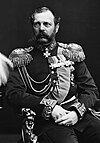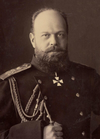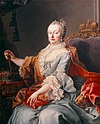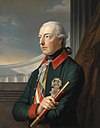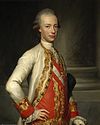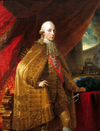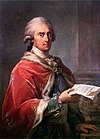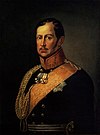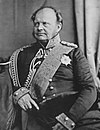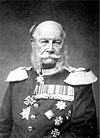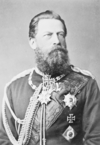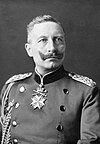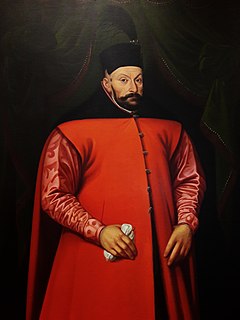
Stephen Báthory was Voivode of Transylvania (1571–1576), Prince of Transylvania (1576–1586), King of Poland and Grand Duke of Lithuania (1576–1586).

Masovian Voivodeship is the largest and most populous of the 16 Polish provinces, or voivodeships, created in 1999. It occupies 35,579 square kilometres (13,737 sq mi) of east-central Poland, and has 5,411,446 inhabitants. Its principal cities are Warsaw in the centre of the Warsaw metropolitan area, Radom (212,230) in the south, Płock (119,709) in the west, Siedlce (77,990) in the east, and Ostrołęka (52,071) in the north. The capital of the voivodeship is the national capital, Warsaw.

Hetman is a political title from Central and Eastern Europe, historically assigned to military commanders.
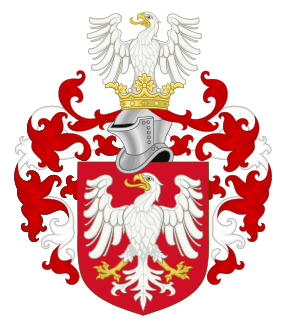
The Piast dynasty was the first historical ruling dynasty of Poland. The first documented Polish monarch was Duke Mieszko I. The Piasts' royal rule in Poland ended in 1370 with the death of king Casimir III the Great.

The Polish–Lithuanian Commonwealth, formally known as the Kingdom of Poland and the Grand Duchy of Lithuania, and, after 1791, as the Commonwealth of Poland, was a country and bi-federation of Poland and Lithuania ruled by a common monarch in real union, who was both King of Poland and Grand Duke of Lithuania. It was one of the largest and most populous countries of 16th to 17th-century Europe. At its largest territorial extent, in the early 17th century, the Commonwealth covered almost 1,000,000 square kilometres (400,000 sq mi) and as of 1618 sustained a multi-ethnic population of almost 12 million. Polish and Latin were the two co-official languages.

The Warsaw Confederation, signed on 28 January 1573 by the Polish national assembly in Warsaw, was one of the first European acts granting religious freedoms. It was an important development in the history of Poland and of Lithuania that extended religious tolerance to nobility and free persons within the Polish–Lithuanian Commonwealth and is considered the formal beginning of religious freedom in the Polish-Lithuanian Commonwealth. Although it did not prevent all conflict based on religion, it did make the Commonwealth a much safer and more tolerant place than most of contemporaneous Europe, especially during the subsequent Thirty Years' War.

The Crown of the Kingdom of Poland, known also as the Polish Crown, is the common name for the historic Late Middle Ages territorial possessions of the King of Poland, including the Kingdom of Poland proper. The Polish Crown was at the helm of the Polish–Lithuanian Commonwealth from 1569 to 1795.
The Polish Army is the name applied to the military forces of Poland. The name has been in use since the early 19th century, although it can be used to refer to earlier formations as well. Polish Armed Forces consist of the Army, Navy and Air Force branches and are under the command of the Ministry of National Defense.
Elections in Poland refers to the election process as well as the election results in Poland. Poland has a multi-party political system. On the national level, Poland elects the head of state – the president – and a legislature. There are also various local elections, referendums and elections to the European Parliament.

Chancellor of Poland was one of the highest officials in the historic Poland. This office functioned from the early Polish kingdom of the 12th century until the end of the Polish–Lithuanian Commonwealth in 1795. A respective office also existed in the Grand Duchy of Lithuania since the 16th century. Today the office of the chancellor has been replaced by that of the Prime Minister.

The Christianization of Poland refers to the introduction and subsequent spread of Christianity in Poland. The impetus to the process was the Baptism of Poland, the personal baptism of Mieszko I, the first ruler of the future Polish state, and much of his court. The ceremony took place on the Holy Saturday of 14 April 966, although the exact location is still disputed by historians, with the cities of Poznań and Gniezno being the most likely sites. Mieszko's wife, Dobrawa of Bohemia, is often credited as a major influence on Mieszko's decision to accept Christianity.
The ideas of the Age of Enlightenment in Poland were developed later than in Western Europe, as the Polish bourgeoisie was weaker, and szlachta (nobility) culture (Sarmatism) together with the Polish–Lithuanian Commonwealth political system were in deep crisis. The period of Polish Enlightenment began in the 1730s–40s, peaked in the reign of Poland's king, Stanisław August Poniatowski, went into decline with the Third Partition of Poland (1795) – a national tragedy inspiring a short period of sentimental writing – and ended in 1822, replaced by Romanticism.
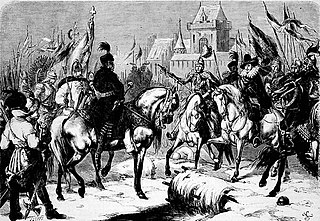
The War of the Polish Succession or the Habsburg-Polish War took place from 1587 to 1588 over the election of the successor to the King of Poland and Grand Duke of Lithuania Stephen Báthory. The war was fought between factions of Sigismund III Vasa and Maximilian III, with Sigismund eventually being crowned King of Poland and Grand Duke of Lithuania. Two major battles of this conflict included the Siege of Kraków, in which Maximilian III failed to capture the capital of the Commonwealth, and the Battle of Byczyna, in which Maximilian was forced to surrender. Sigismund's victory was significantly the doing of Chancellor and Hetman Jan Zamoyski, who stood behind both the political intrigue and the military victories of this conflict.
The order of precedence for members of the Sejm (parliament) of the Polish–Lithuanian Commonwealth was created at the same time as the Commonwealth itself – at the Lublin Sejm in 1569. The Commonwealth was a union, in existence from 1569 to 1795, of two constituent nations: the Crown of the Kingdom of Poland and the Grand Duchy of Lithuania. The union's legislative power was vested in a diet (assembly) known as the Sejm which consisted of the three Estates of the Sejm: the monarch, holding the titles of King of Poland and Grand Duke of Lithuania; the Senate; and the House of Deputies.

The early modern era of Polish history follows the late Middle Ages. Historians use the term early modern to refer to the period beginning in approximately 1500 AD and lasting until around 1800.
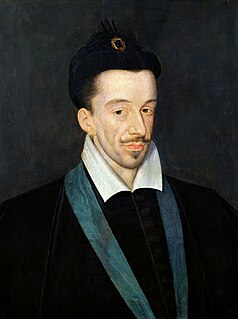
The free election of 1573 was the first ever royal election to be held in the Polish–Lithuanian Commonwealth. It gathered approximately 40,000 szlachta voters who elected Henry of Valois king.

The Seven Years' War, which ended in 1763, established a new pattern of political alliances in Europe. The Kingdom of Prussia, the Kingdom of Great Britain and the Russian Empire emerged as great powers, while the position of Austria, France, Spain, Sweden and the Ottoman Empire was weakened. As a result of the war, the Russian Empress, Catherine the Great, was in almost complete control of the Polish–Lithuanian Commonwealth. Catherine was supported by the Prussian monarch, Frederick the Great, who hoped to eventually annex Polish provinces of Royal Prussia and Greater Poland.


